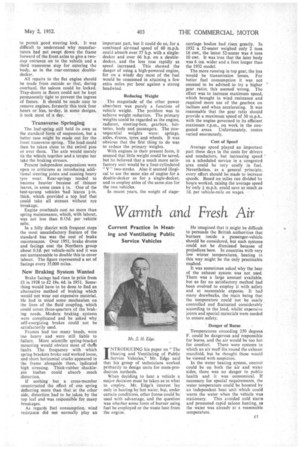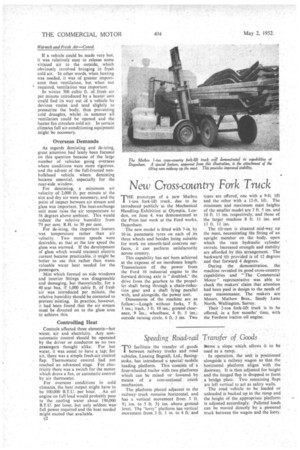Warmth and Fresh Air .
Page 39

Page 40

If you've noticed an error in this article please click here to report it so we can fix it.
INTRODUCING his paper on "The Heating and Ventilating of Public Service Vehicles," Mr. Edge said that his group of technicians worked primarily to design units for mass-production methods.
When deciding to heat a vehicle a major decision must be taken as to what to employ. •Mr. Edge's interest lay only in heating by hot water, lant, under certain conditions, other forms could be used with advantage, and the question was whether some form of burner using fuel be employed or the waste heat from the engine. He imagined that it might be difficult to persuade the British authorities that burners inside a passenger-vehicle should be considered, but such systems could not be dismissed because of prejudices here. In countries with very low winter temperatures, heating in this way might be the only practicable method.
It was sometimes asked why the heat of the exhaust system was not used. There was a large amount available, but so far no satisfactory method had been evolved to employ it with safety and at reasonable expense. It had many drawbacks, the main being that the temperature could not be easily controlled and fluctuated considerably according to the load, whilst expensive joints and special materials were needed to ensure safety.
Danger of -Burns
Temperatures exceeding 250 degrees F. could be dangerous and responsible for burns, and the air would be too hot for comfort. There were systems in which an air muff fits round the exhaust manifold, but he thought these would be viewed with suspicion. '
In the water heating system, control could be on both the air and water Sides; there was no danger to public health and it was economical. If necessary for special requirements, the water temperature could be boosted by an independent heat unit 'which could warm the water when the vehicle was stationary. This avoided cold starts and promoted rapid saloon heating, as the water was already at a reasonable temperature. If a vehicle could be .made very hot, it was relatively easy to release some vitiated air to the outside; which obviously involved bringing in fresh cold air. In other words, when heating was needed, it was of greater importance than ventilation, but when not required, ventilation was important.
In winter 300 cubic ft. of fresh air per minute introduced by a heater unit could find its way out of a vehicle by devious routes and tend slightly to pressurize the body, thus preventing cold draughts, whilst -in summer all ventilators could be opened and the heater fan circulate cold air. In certain climates full air-conditioning equipment might be necessary.
Overseas Demands
As regards demisting and de-icing. great attention had lately been focused on this question because of the large number of vehicles. going overseas where conditions were more rigorous, and the advent of the full-fronted nonbulkhead vehicle where demisting became essential, especially for the near-side window.
For demisting, a minimum air velocity of 2,000 ft. per minute at the slot and dry air were necessary, and the point of impact between air stream and glass was important. The heat-exchange unit must raise the air temperature to 56 degrees above ambient. This would reduce the relative humidity from 79 per cent. R.H. to 30 per cent.
For de-icing, the important feature was temperature rather than air velocity. Two motor speeds were desirable, so that at the low speed the glass was warmed. If the development of glass which would transmit electric current became practicable, it might be better to use this rather than waste valuable water heat needed for the passengers.
Mist which formed on side windows and interior fittings' was disagreeable and damaging, but theoretically, for a 40 seat bus, if 1,000 cubic ft. of fresh air was introduced per minute, the relative humidity should be corrected to prevent misting. In practice, however, it had been found that the air stream must be directed on to the glass area to achieve this.
Controlling Heat
Controls affected three elements—hot water, air and electricity. Any nonautomatic control should be operated by the driver or conductor as no two passengers thought alike. For hot water, it was usual to have a tap; for air, there was a simple fresh-air control flap. Thermostatic control had not reached an advanced stage. For electricity there was a switch for the motor which drove a fan, or automatic control by air thermostat. .
For overseas conditions in cold climates, the heat output might have to be 100,000 B.T.U. per hour. An oil engine on full load would probably pass to the cooling water about 190,000 B.T.U. per hour, but only seldom wasfull power required and the heat needed might exceed that available.
c2




















































































